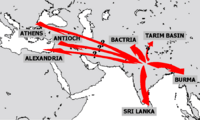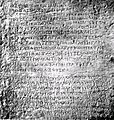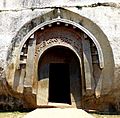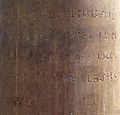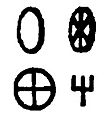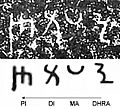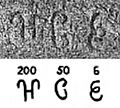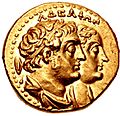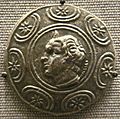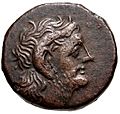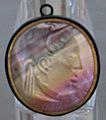Edicts of Ashoka facts for kids
The Edicts of Ashoka are a collection of 33 inscriptions on the Pillars of Ashoka, as well as on large stones and cave walls, made by the Emperor Ashoka of the Mauryan dynasty during his reign from 272 to 231 BCE. The edicts describe in detail the first wide expansion of Buddhism. According to the edicts, the extent of Buddhist proselytism during this period reached as far as the Mediterranean, and many Buddhist monuments were created.
Ashoka did not completely forbid the killing of animals; he wanted restraint in the number that had to be killed for consumption, protected some of them, and in general condemned violent acts against animals.
Images for kids
-
Brahmi script consonants, and their evolution down to modern Devanagari, according to James Prinsep, as published in the Journal of the Asiatic Society of Bengal, in March 1838. All the letters are correctly deciphered, except for two missing on the right: 𑀰(ś) and 𑀱(ṣ).
-
The full title Devanampiyasa Piyadasino Asokaraja (𑀤𑁂𑀯𑀸𑀦𑀁𑀧𑀺𑀬𑀲 𑀧𑀺𑀬𑀤𑀲𑀺𑀦𑁄 𑀅𑀲𑁄𑀓𑀭𑀸𑀚) in the Gujarra inscription.
-
The Prakrit word "Dha-ṃ-ma" (𑀥𑀁𑀫, Sanskrit: Dharma) in the Brahmi script, as inscribed by Ashoka in his Edicts. Topra Kalan pillar, now in New Delhi.
-
Animals pervade imperial Mauryan art. Rampurva bull capital established by Ashoka, 3rd century BCE. Now in the Rashtrapati Bhavan Presidential Palace, New Delhi.
-
The words "Bu-dhe" (𑀩𑀼𑀥𑁂, the Buddha) and "Sa-kya-mu-nī " ( 𑀲𑀓𑁆𑀬𑀫𑀼𑀦𑀻, "Sage of the Shakyas") in Brahmi script, on Ashoka's Rummindei Minor Pillar Edict (circa 250 BCE).
-
The Seleucid king Antiochos ("Aṃtiyakā", "Aṃtiyako" or "Aṃtiyoga" depending on the transliterations) is named as a recipient of Ashoka's medical treatments, together with his Hellenistic neighbours.
-
"Aṃtiyako Yona Rājā" ("The Greek king Antiochos"), mentioned in Major Rock Edict No.2, here at Girnar. Brahmi script.
-
Top: Wheels in Egyptian temples according to Hero of Alexandria. Bottom: Possible wheel and trisula symbol on Ptolemaic tombstones in Egypt.
-
The word Lipī (𑀮𑀺𑀧𑀻) used by Ashoka to describe his "Edicts". Brahmi script (Li=𑀮La+𑀺i; pī=𑀧Pa+𑀻ii).
-
The same expression Dhamma Lipi ("Dharma inscriptions") in Brahmi script (𑀥𑀁𑀫𑀮𑀺𑀧𑀺), Delhi-Topra pillar.
-
The number "256" in Ashoka's Minor Rock Edict No.1 in Sasaram
-
The Edicts of Ashoka started a tradition of epigraphical inscriptions. 1800 years separate these two inscriptions: Brahmi script of the 3rd century BCE (Major Pillar Edict of Ashoka), and its derivative, 16th century CE Devanagari script (1524 CE), on the Delhi-Topra pillar.
-
Seleucid king Antiochus II Theos of Syria (261–246 BCE).
-
Ptolemy II Philadelphos of Egypt (285–247 BCE) with his sister Arsinoe II.
-
Antigonus II Gonatas of Macedon (278–239 BCE).
See also
 In Spanish: Edictos de Ashoka para niños
In Spanish: Edictos de Ashoka para niños


